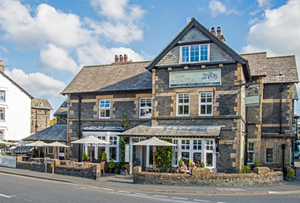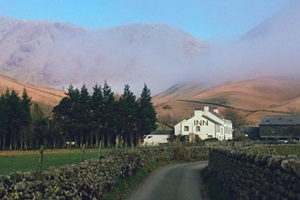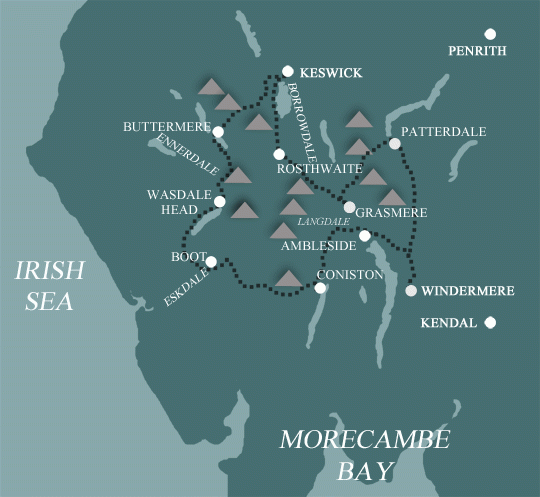Tour of the Lake District
The Tour of the Lake District in 9 Days Walking Code: TL10
We offer 2 itineraries on the Tour of the Lake District. This captivating trail takes you through some of the Lake District’s most iconic landscapes, from tranquil lakeshores and charming villages to rugged mountain passes. Starting in Windermere, the route heads to Ambleside then leads you through each of the main Lakeland valleys before completing the circuit back in Ambleside.
Walking the 96 miles in 9 days results in a daily average of just 11 miles, however there is one unusually lengthy day of 18 miles walking from Keswick to Grasmere. Our 10 day itinerary avoids this by splitting this section over 2 days.
| Miles | Km | ||
|---|---|---|---|
| Day 1 | Travel to Windermere for your first nights accommodation | ||
| Day 2 | Windermere to Ambleside | 6 | 10 |
| Day 3 | Ambleside to Coniston | 13 | 21 |
| Day 4 | Coniston to Boot | 11 | 18 |
| Day 5 | Boot to Wasdale Head | 11 | 18 |
| Day 6 | Wasdale Head to Buttermere | 8 | 13 |
| Day 7 | Buttermere to Keswick | 10 | 16 |
| Day 8 | Keswick to Grasmere | 18 | 29 |
| Day 9 | Grasmere to Patterdale | 8 | 13 |
| Day 10 | Patterdale to Ambleside | 11 | 18 |
| Day 11 | Depart from Ambleside after breakfast |
Windermere to Coniston
Your first day begins in the popular tourist town of Windermere. Leaving Windermere on well-defined paths, you gain height and are rewarded with great views over Lake Windermere and the ground you will cover in the next day or so. The route continues along the old drovers road past historic Townend farm, which is open to the public and offers a great insight into 17th Century Lakeland life. Further along the viewpoint at Jenkin Crag is worth a short detour before continuing to the bustling town of Ambleside. On leaving Ambleside, the route climbs below Loughrigg Fell, past Loughrigg Tarn on easy to follow trails before arriving in the village of Elterwater which guards the entrance to the beautiful Langdale Valley in the heart of the Lake District. From Elterwater, a well-defined path leads out of the valley and journeys alongside Tarn How’s before descending to the charming village of Coniston, the one-time home of the poet John Ruskin.
Coniston to Boot
This stage of the route follows the old Walna Scarr Road under the shadow of the Old Man of Coniston over to the peaceful Duddon Valley before climbing again over the mossy fell to Eskdale. The walking is generally easy with no steep climbing, but you will be surprised to learn that by the end of the day, following two gradual ascents of Walna Scar in the morning and Ulpha Fell in the afternoon, your total ascent for the day will be almost 900m! Skirting around the side of Harter Fell and following the River Esk for a short while brings you into Boot. The more adventurous among you can follow the high level alternative which involves climbing the Old Man of Coniston before continuing on undemanding terrain to follow the Hardknott Pass into Boot.
Boot to Buttermere
Rejoining the River Esk downstream to Eskdale Green, you cross over the old Eskdale to Ravenglass railway line. An easy climb through the ash and birch woodland of Miterdale Forest on a wooded bridleway brings you to the top of Irton Fell. Descending into the valley down the flanks of Irton Fell, the remote Wastwater finally reveals itself. You then have the choice of traversing the western side of Wastwater on loose scree slopes or the easier option of following the road along the eastern side to the Wasdale Head Inn. From Wasdale Head the route skirts Kirk Fell through Mosedale, an easy level walk along the valley floor in the shadow of Pillar before climbing up to the col of Black Sail Pass. Descending into Ennerdale, you pass the remote Black Sail Youth Hostel before a gentle climb brings you to Scarth Gap Pass. The descent into the Buttermere Valley requires care as the paths are rocky which can become slippery if it is wet, before picking up the main path along the shore of Buttermere into the village itself.
Buttermere to Keswick
Starting in the quiet woodlands of Buttermere, the route climbs steadily out of Buttermere following a well-defined path over the fell sides above Sail Beck around 200m (650ft) to the top of Rigg Beck. Once the pass is reached, the path drops down again to the peaceful Newlands valley where the route meanders on before skirting the slopes of Catbells. Many of Beatrix Potter’s stories are set in this area. A higher level route via the top of Catbells, one of the most popular short climbs in the Lake District, rewards you with spectacular views of the northern fells, Skiddaw and the lakes of Derwentwater and Bassenthwaite, en route to the bustling market town of Keswick.
Keswick to Grasmere
Leaving Keswick the route heads for Castlerigg Stone Circle before crossing farmland to reach the popular viewpoint of Walla Crag. From there a broad path descends to the packhorse bridge at Ashness before entering an upland valley leading to the tiny community of Watendlath. After a short climb it’s an easy descent into the Borrowdale Valley at Rosthwaite. Following a clear path from Rosthwaite alongside Stonethwaite Beck, the trail then becomes rockier underfoot before climbing up the remote Greenup Gill to Greenup Edge on a steep but obvious path. You then have the choice to take the easier route down to the valley of Far Easedale, which is often boggy underfoot or over the Lion and the Lamb on Helm Crag into Grasmere. This is a memorable day with views of Lakeland fells in all directions.
Grasmere to Patterdale
The villages of Grasmere and Patterdale are split by a high mountain range, the longest high level range in Lakeland. The route lies over the Helvellyn range and you can choose to walk either over the pass at Grisedale Tarn, or for the more adventurous, via the summit of Helvellyn, England’s 3rd highest mountain, before dropping down to Patterdale on the shores of Ullswater.
Patterdale to Ambleside
The last stage of the Tour sees you leaving the shores of Ullswater in the direction Brothers Water. Passing to the west of Brothers Water the trail climbs alongside Caiston Beck, arriving at Scandale Pass before turning to reach the summit of Red Screes, offering exceptional 360 degree views on a clear day. From Red Screes it’s a superb ridge walk down into Ambleside and the completion of your Tour of the Lake District!
Challenging
The Tour of the Lake District is a challenging walk in places, and you will need to be proficient in map reading and navigating with a compass. Do not hesitate to contact us if you have any queries regarding the suitability of this walk, we are happy to advise.
Terrain: A mixture of forest paths, wooded lake shores and tracks following the lower slopes of the fells, with several mountain passes but none more than 550m / 1800ft in altitude.
How Much Up & Down? The average daily ascent is 625m / 2050ft, but the actual climbing varies each day from 360m / 1180ft (Windermere to Ambleside) to around 900m / 2950ft (Coniston to Boot).
What’s it like underfoot? The paths and tracks that are followed on this route are well defined and maintained. There are occasional sections where the path, while still well defined, becomes rougher on higher ground.
Signposting: There are no official route waymarks and you will need to use your guidebook and map to follow the paths and tracks on the ground.
Navigation: The paths are well defined, but you will need to read a map and use the route description in your guidebook. You spend some time on higher ground and may encounter mist and hill fog so the ability to use a compass is essential. While the footpaths the route follows are marked on the map, the route itself is not highlighted.
Weather: You may be lucky enough to encounter warm, dry weather over the whole route and enjoy dry paths and tremendous views, but you must be prepared because the weather can change quickly. Remember you are spending time on higher ground, where it will be colder than in the valleys. Good clothing and waterproofs essential!
|
All Holidays
|
|
| Accommodation | Overnight Bed and Breakfast accommodation in selected hotels, farmhouses, village inns, guest houses and family B&Bs. Full English or Continental breakfast. |
| Guidebook |
A detailed guidebook with route information, maps, photos and background information. |
| Information of Services Along the Route | A comprehensive Service Info sheet, including services such as cash points, banks, post offices, village shops, inns, cafes and taxis. |
| Maps | Four (1:25,000) Ordnance Survey Explorer maps, including mobile download, covering the entire route. |
| Personal Itinerary | A personal itinerary setting out each overnight stop, including large scale maps of each accommodation, to ensure you find it easily. |
| Emergency Telephone Support | If you get in to difficulties during your holiday, we are always available to help, even out of office hours. |
|
Options
|
|
| Luggage Transport | We will transfer your luggage between each overnight stop – if you leave your luggage at the accommodation when you set off in the morning, it will be moved on to your next B&B. You only need to carry a small day sack with the clothes and provisions you require during the day’s walk. |
| Packed Lunches |
Provided for each day’s walking and recommended on this holiday as there will not always be a handy shop or cafe on the route. |
| Off Road Parking | If you are travelling by car we can usually arrange off road parking for the duration of your trip. (There may be a small charge for this). |
|
What’s not Included
|
|
| Evening Meals | Your evening meal isn’t included in the package, but we include full details and recommendations for each evening meal in your itinerary. You will normally be within walking distance of a pub and/or restaurant, or where there is good food available at the accommodation, we’ll book that for you. Allow about £30.00 per night. |
| Transport to the Start & Away from the Finish | Have a look at the ‘Travel Info’ tab above for suggestions. If you’re still struggling, get in touch and we’ll help you sort it out. |
| Travel Insurance | Even if you are based in the UK travel insurance is worth having. |
Good accommodation and friendly hosts are an essential part of any holiday. We understand this and go out of our way to find the best. We put a great deal of effort into hand picking our accommodation and matching it to individual customer requirements. As well as visiting the accommodation ourselves, we ask all our customers to complete a short evaluation on each night’s accommodation, which then gives us an insight into the day-to-day operation and lets us spot any potential issues before they become a problem.
We use a variety of accommodation. Over the course of your trip you might stay in a village inn, a bed and breakfast in a converted barn, a Victorian guest house, or on a working farm. In selecting the accommodation we look for helpful, friendly hosts with good quality, characterful accommodation close to the trail. Occasionally we may use a chain hotel.
We always try to arrange en suite accommodation, i.e. rooms with their own bathrooms for each night of your stay. However, in some of the more remote locations accommodation is limited and occasionally we may have to book rooms with shared bathrooms for one or two nights of your holiday, (especially if the booking is made at short notice), but we will always let you know if this is likely to be the case.
We are happy to book single rooms on our holidays but cannot normally book more than two for any one group. Single room bookings include a supplement.
Here are some examples of the accommodation we use on the Tour of the Lake District:
 The Archway Guest House, nestled in the heart of the popular tourist destination of Windermere, offers a warm welcome and distant views of the Lakeland fells. Hosts Denis and Anita ensure a memorable stay, enhanced in no small part by a hearty breakfast menu, including their not to be missed, special Caribbean option. Visit their website
The Archway Guest House, nestled in the heart of the popular tourist destination of Windermere, offers a warm welcome and distant views of the Lakeland fells. Hosts Denis and Anita ensure a memorable stay, enhanced in no small part by a hearty breakfast menu, including their not to be missed, special Caribbean option. Visit their website
 The Yewdale Inn, located in the centre of Coniston village in the Lake District, offers a traditional country escape. Its nine en suite guest rooms ensure a comfortable and cosy stay, with views of the stunning Coniston fells or the charming village church. A welcoming retreat after a day on the trail or exploring the Lakeland fells. Visit their website
The Yewdale Inn, located in the centre of Coniston village in the Lake District, offers a traditional country escape. Its nine en suite guest rooms ensure a comfortable and cosy stay, with views of the stunning Coniston fells or the charming village church. A welcoming retreat after a day on the trail or exploring the Lakeland fells. Visit their website
 The Wasdale Head Inn, steeped in history, sits in the shadow of England’s highest peak, Scafell Pike. Welcoming travellers for over two centuries, it has hosted figures such as Wordsworth, Coleridge, and Dickens. Today, it offers timeless charm, great hospitality, and a connection to the Lake District’s literary and mountaineering heritage. Visit their website
The Wasdale Head Inn, steeped in history, sits in the shadow of England’s highest peak, Scafell Pike. Welcoming travellers for over two centuries, it has hosted figures such as Wordsworth, Coleridge, and Dickens. Today, it offers timeless charm, great hospitality, and a connection to the Lake District’s literary and mountaineering heritage. Visit their website
 Glaramara, located at the southern end of Borrowdale Valley just seven miles from the market town of Keswick, offers a welcoming retreat surrounded by breathtaking fell views. It’s an ideal choice for walkers exploring iconic routes such as Scafell Pike and Great Gable. Guests enjoy a cosy lounge and bar with log fires, and a lovely restaurant. Visit their website
Glaramara, located at the southern end of Borrowdale Valley just seven miles from the market town of Keswick, offers a welcoming retreat surrounded by breathtaking fell views. It’s an ideal choice for walkers exploring iconic routes such as Scafell Pike and Great Gable. Guests enjoy a cosy lounge and bar with log fires, and a lovely restaurant. Visit their website
General travel information on the Lake District area will be in your holiday pack including train and bus timetables where available.
Detailed instructions on getting to your first night’s accommodation by car, or on foot from the nearest train or bus station, will also be included in the holiday pack on individual accommodation maps.
To view train times please visit trainline where you can also purchase tickets in advance. For information on bus timetables please visit traveline
If you require secure car parking whilst walking this route, please contact us for information.
Getting to Windermere:
By Air: The nearest international airports are Manchester (MAN), Newcastle (NCL) or Glasgow (GLA). You can travel by train to Windermere.
By Public Transport: Train to Windermere from Oxenholme main line station.
By Road: From the South: From the M6 take the A65 (Junction35), then the A591 to Windermere. About 20 minutes from the motorway.
From the North: From the M6 take the A66 (Junction 40), then the A591 to Windermere. About 40 minutes from the motorway.
Returning from Ambleside:
By Public Transport: Travel by bus or taxi to Windermere (4 miles) for rail travel connecting with the west coast main line.
By Road: Retrace your journey on the A591 to either the A65 or A66 before joining the M6
Windermere
The linked towns of Windermere and Bowness at the heart of the Lake District have been an attraction for visitors since Victorian times. With the lake shore of Windermere so close, there is always something to do whatever the season - walking along the lakeside, enjoying panoramic views of the lake and mountains from several viewpoints, experiencing a whole host of water-based activities, luxuriating in the pleasures of travelling around the area by steamer, open-top bus or steam locomotive or discovering the lake for yourself by hiring a rowing boat, dinghy or cruiser. Away from the lake shore is a varied choice of heritage sites, historic houses, colourful gardens and other visitor attractions.
Ambleside
Ambleside is a bustling Lakeland town, with charming shops and a wide choice of good cafes and restaurants. The small town is known for its landmark Bridge House and its connections with writers, poets and artists including Beatrix Potter. There are many short walks that can be enjoyed from here, or you can wander down to Waterhead and take a ride on one of the Windermere “Steamers” on the lake.
Coniston
A pleasant Lakeland Village on the shores of Lake Coniston. Take a cruise on the lake on the steam launch “Gondola”. Visit historic Brantwood, nineteenth century home of John Ruskin. For the more energetic, Coniston Old Man is a great walk with tremendous views over the Lake District and Morecambe Bay.
Keswick
Keswick is a bustling market town centred around the historic Moot Hall, with a vast array of outdoor shops – if you need any outdoor gear, you will get it here! There is a wide choice of places to eat or have a coffee, and a range of galleries to visit. Enjoy one of the easy, short walks down to the lakeshore from where there is a regular launch service around Derwentwater. Or pop into our offices to say hello or book your next holiday!
Grasmere
Grasmere is a charming village right in the heart of the Lake District National Park and a great location to spend a well earned rest day. It was once the home of the famous poet William Wordsworth and today you can visit two of his former homes - Dove Cottage and Rydal Mount. In the centre of Grasmere is St. Oswald’s Church, which contains the Wordsworth family graves. The village itself has narrow bustling streets with cafes, shops and pubs. The frequent local bus service connects Grasmere with Keswick and Ambleside if you want to explore further into the Lakes.
Patterdale
Patterdale offers spectacular scenery in a peaceful location. This tiny village in the heart of the English Lake District will give you a well earned rest before heading onwards on your walking route. Boat trips can be taken on the Ullswater Steamers to Pooley Bridge, with several opportunities to disembark and explore the lakeshore attractions along the way.
| Prices | GBP (£) |
|---|---|
| Accommodation, map & guidebook only | £1346 |
| with Luggage Transport | £1598 |
| with Packed Lunches | £1449 |
| with Luggage & Lunches | £1690 |
Other Options |
|
| Extra Nights (per night) | £95 |
| Single Supplement (per night) | £65 |
| Solo Luggage Supplement (per day) | £28 |
